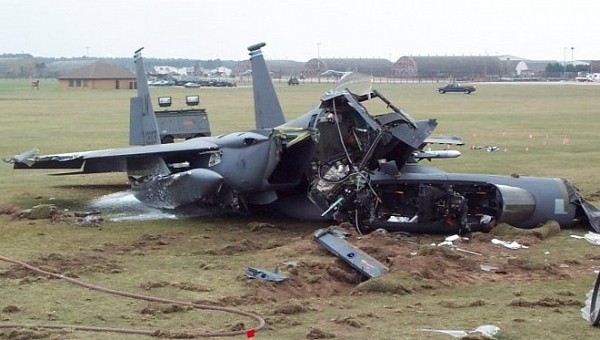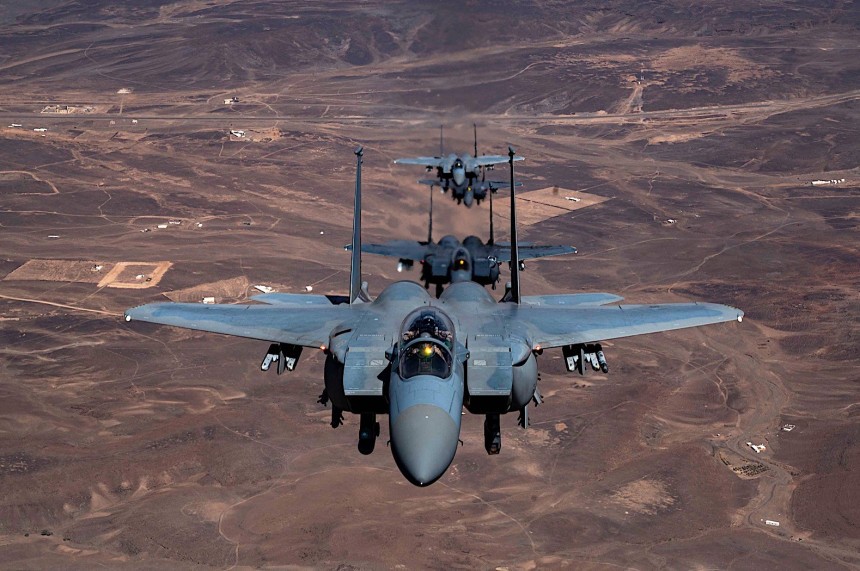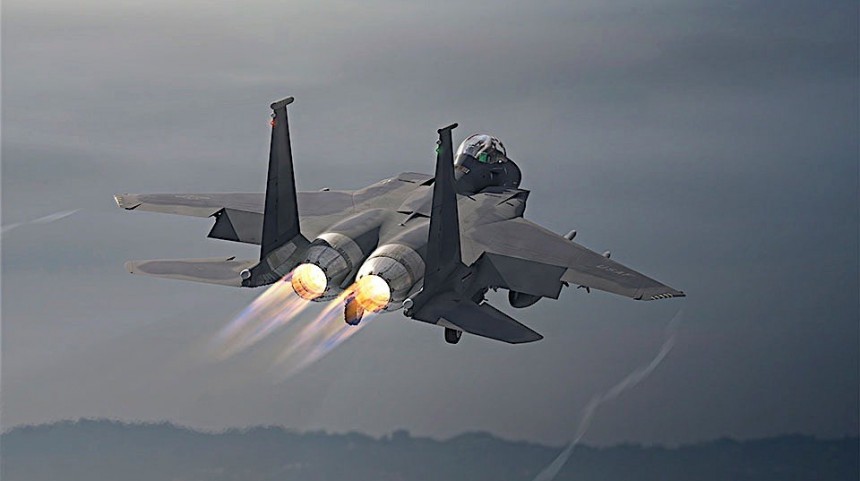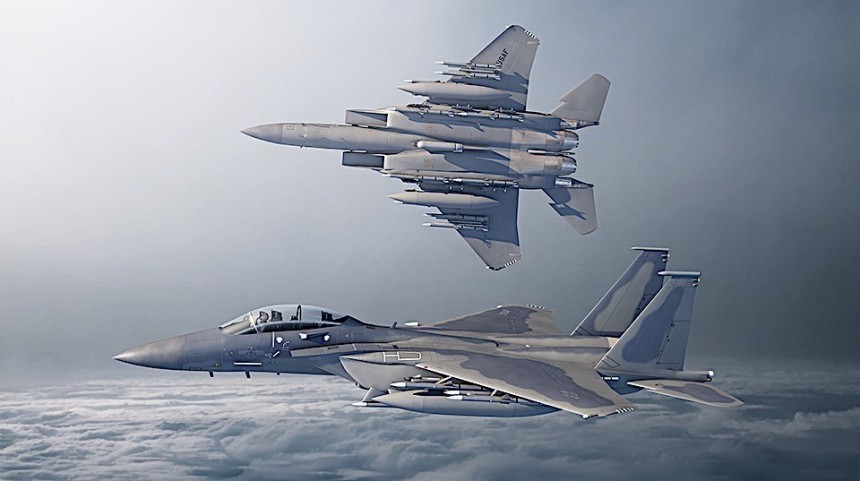One hundred four confirmed kills and zero losses. This is the defining statistic of the McDonnell Douglas F-15 Eagle and all its variants. But don't let the barely hidden propaganda tell you otherwise. The F-15 is not an invincible wonder plane. In fact, its accident history is stunningly long.
Wikipedia is rarely an arbiter of absolute truth. Still, their list of confirmed F-15 airframe losses dates back to the mid-1970s, has well over 100 entries, and spans the jet's service with the United States, Japan, South Korea, Israel, and Saudi Arabia. It's also backed by years of official Air Force loss or "mishap" reports. If you're one of the F-15's many public supporters, this might come as quite a shock.
The last detailed report from the U.S. Air Force regarding F-15 hull losses covers every operational year from the plane's introduction in 1972 to 2013. Among those accounted for, 123 of the U.S. Air Force F-15 airframes have been lost to mishaps and accidents. 52 further losses occurred with all other nations combined.
Things started well enough, as no F-15s were lost from 1972 to 1974. But, as you'll find, the first hull-loss accident involving an F-15A on October 14th, 1975, opened the floodgates. In this accident over Minersville, Utah, the pilot was forced to eject after the cockpit suddenly filled with smoke from behind the instrument panel. But hey, there were certainly aircraft flying with the U.S. with worse safety records at that time.
But then, on February 28th, 1977, another F-15A collided mid-air with a Northrop F-5E over Nellis Air Force Base in Nevada. Both pilots managed to survive without injury. This was the first of a dozen-plus mid-air collision incidents attributed to F-15s. Nearly four years later to the date in 1981, another F-15, this time a B-model, collided mid-air. Yet again, the jet on the receiving end was an F-5E. Killing the pilot and crew of all parties involved.
If that doesn't get you believing in superstition, we don't know what will. Before the year was out, two further F-15s suffered a mid-air collision, killing both pilots. What's even freakier is that F-15's collided with Northrop F-5Es on three separate occasions. In September 1981, an F-15C of the 36th TFW-wing sporting less than ten flight hours on the clock crashed during landing at a Dutch air show.
Like an absolute unit, the pilot stayed with the aircraft, not ejecting as the eight-figure, shiny new fighter jet impacted and then skidded down the runway. Don't think the F-15's two-seater twin, the Strike Eagle, was immune from its fair share of catastrophic accidents. On April 18th, 1995, Air Force Captain Brian Udell and radar officer Captain Dennis White were conducting high G-force maneuvering exercises when Udell lost a visual of the horizon at supersonic speeds.
With little time to react, Udell ejected not a moment too soon. The ferocious force of the wind at roughly Mach 1.2 broke or dislocated nearly every bone in Capt. Udell's arms and legs, apart from the left arm. He managed to climb into the liferaft integrated into his F-15's ejection seat and floated off the coast of North Carolina for four agonizing hours before rescue.
The ejection forces killed Captain Dennis White instantly as his body impacted supersonic turbulence. Of any F-15-related accident we could find in which someone survived, this incident was perhaps the most brutal. Captain Udell's accident qualifies as pilot-error-related only because there was no underlying mechanical issue or enemy combatant present to chalk the incident down to some other fault.
His survival in the face of nearly certain death is still well-celebrated in military aviation circles. Pilot error accounts for a substantial portion of the F-15's total accident history, but not entirely. As it happens, even the most vicious and deadly fighter jet ever devised has some mechanical shortcomings and shocking oversights. In November 2007, an F-15C of the Missouri Air National Guard's 131st fighter wing crashed near metropolitan St. Louis. Very nearly ending the life of the pilot Maj. Stephen W. Stilwell.
But like Captain Udell, he managed to escape with his life, albeit with serious injuries. Shockingly, the accident was attributed to structural failure on the part of the F-15. Investigations revealed key portions of load-bearing parts of the F-15's airframe were starkly and shockingly not built to Air Force specifications. With the entire fleet now at risk, the U.S. grounded all non-mission-critical F-15s and F-15Es until inspections of each airframe were finished.
In total, approximately 52 souls have been lost in accidents involving the F-15 and all its variants throughout its half-century-long service history. One can only wonder if this number equals or even surpasses the number of people the F-15's killed in combat. One thing is for sure; seeing an aircraft as universally adored as the Eagle and Strike Eagle have such a checkered safety rating is nothing short of astonishing.
Of course, the F-15 is far from the least safe fighter jet ever made. The Lockheed F-104 Starfighter and the Harrier VTOL come to mind as having crash histories that are somehow even worse. But where you sort of expect a VTOL jet fighter to have a crash record like a Nissan and the F-104's reputation as a deathtrap is well established, the opposite is true of the F-15.
Interestingly, the Aviation Safety Network database pegs the F-15's total accident rate at a respectable one loss per 50,000 flight hours. So to say, without so many incidents of pilot error, the F-15 is indeed a very reliable airframe. That said, it's by no means unbreakable. As it happens, the F-15's greatest enemy isn't MiG-31s, MiG-29s, or MiGs of any variety. Instead, it's the F-15's pilots themselves.
If nothing else, this only speaks to how capable the Eagle is in a dogfight. You know, the thing the Pentagon spent trillions of dollars and well north of five decades trying to make it proficient at in the first place. With that kind of money floating around, the U.S. Air Force can afford these kinds of hull loss rates.
Check back soon for more from Celebration Month 2022 here on autoevolution.
The last detailed report from the U.S. Air Force regarding F-15 hull losses covers every operational year from the plane's introduction in 1972 to 2013. Among those accounted for, 123 of the U.S. Air Force F-15 airframes have been lost to mishaps and accidents. 52 further losses occurred with all other nations combined.
Things started well enough, as no F-15s were lost from 1972 to 1974. But, as you'll find, the first hull-loss accident involving an F-15A on October 14th, 1975, opened the floodgates. In this accident over Minersville, Utah, the pilot was forced to eject after the cockpit suddenly filled with smoke from behind the instrument panel. But hey, there were certainly aircraft flying with the U.S. with worse safety records at that time.
But then, on February 28th, 1977, another F-15A collided mid-air with a Northrop F-5E over Nellis Air Force Base in Nevada. Both pilots managed to survive without injury. This was the first of a dozen-plus mid-air collision incidents attributed to F-15s. Nearly four years later to the date in 1981, another F-15, this time a B-model, collided mid-air. Yet again, the jet on the receiving end was an F-5E. Killing the pilot and crew of all parties involved.
Like an absolute unit, the pilot stayed with the aircraft, not ejecting as the eight-figure, shiny new fighter jet impacted and then skidded down the runway. Don't think the F-15's two-seater twin, the Strike Eagle, was immune from its fair share of catastrophic accidents. On April 18th, 1995, Air Force Captain Brian Udell and radar officer Captain Dennis White were conducting high G-force maneuvering exercises when Udell lost a visual of the horizon at supersonic speeds.
With little time to react, Udell ejected not a moment too soon. The ferocious force of the wind at roughly Mach 1.2 broke or dislocated nearly every bone in Capt. Udell's arms and legs, apart from the left arm. He managed to climb into the liferaft integrated into his F-15's ejection seat and floated off the coast of North Carolina for four agonizing hours before rescue.
The ejection forces killed Captain Dennis White instantly as his body impacted supersonic turbulence. Of any F-15-related accident we could find in which someone survived, this incident was perhaps the most brutal. Captain Udell's accident qualifies as pilot-error-related only because there was no underlying mechanical issue or enemy combatant present to chalk the incident down to some other fault.
But like Captain Udell, he managed to escape with his life, albeit with serious injuries. Shockingly, the accident was attributed to structural failure on the part of the F-15. Investigations revealed key portions of load-bearing parts of the F-15's airframe were starkly and shockingly not built to Air Force specifications. With the entire fleet now at risk, the U.S. grounded all non-mission-critical F-15s and F-15Es until inspections of each airframe were finished.
In total, approximately 52 souls have been lost in accidents involving the F-15 and all its variants throughout its half-century-long service history. One can only wonder if this number equals or even surpasses the number of people the F-15's killed in combat. One thing is for sure; seeing an aircraft as universally adored as the Eagle and Strike Eagle have such a checkered safety rating is nothing short of astonishing.
Of course, the F-15 is far from the least safe fighter jet ever made. The Lockheed F-104 Starfighter and the Harrier VTOL come to mind as having crash histories that are somehow even worse. But where you sort of expect a VTOL jet fighter to have a crash record like a Nissan and the F-104's reputation as a deathtrap is well established, the opposite is true of the F-15.
If nothing else, this only speaks to how capable the Eagle is in a dogfight. You know, the thing the Pentagon spent trillions of dollars and well north of five decades trying to make it proficient at in the first place. With that kind of money floating around, the U.S. Air Force can afford these kinds of hull loss rates.
Check back soon for more from Celebration Month 2022 here on autoevolution.


















































